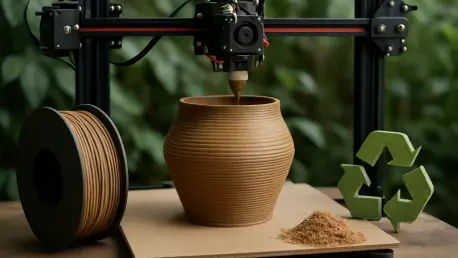I’m thrilled to sit down with Oscar Vail, a technology expert whose passion for innovation has placed him at the forefront of groundbreaking advancements in fields like quantum computing, robotics, and open-source projects. Today, we’re diving into his insights on SustainaPrint, a revolutionary toolkit that’s reshaping the world of 3D printing by blending sustainability with strength. Our conversation explores the inspiration behind this hybrid printing method, the intricate process of balancing eco-friendly and durable materials, the real-world impact of its results, and its potential to transform manufacturing at every level.
Can you tell us what sparked the idea for SustainaPrint and the specific challenges in 3D printing you aimed to tackle?
Absolutely, Grace. The core inspiration for SustainaPrint came from the growing tension between sustainability and performance in 3D printing. Most traditional filaments are petroleum-based, which isn’t great for the environment, and while eco-friendly alternatives like biodegradable plastics exist, they often lack the strength needed for structural or load-bearing parts. We wanted to solve this by creating a system that didn’t force users to choose between being green and building something durable. The challenge was figuring out how to minimize high-performance plastic use while ensuring the printed objects could still handle real-world stress.
How did the concept of combining eco-friendly and stronger materials evolve into a workable solution?
It started with a simple question: why print an entire object with strong material if only certain parts need that durability? We realized that by analyzing stress points in a 3D model, we could strategically place stronger materials only where they’re needed. This led to the development of SustainaPrint’s software, which uses simulations to predict stress areas and pair them with tougher filaments, while the rest of the object uses greener, weaker materials. It took a lot of trial and error, but marrying simulation tech with dual-material printing gave us a practical way to cut down on plastic waste without sacrificing function.
Can you walk us through how SustainaPrint analyzes a 3D model to determine where reinforcement is needed?
Sure. When a user uploads a 3D model into SustainaPrint’s interface, they specify areas where forces will be applied and regions that are fixed in place. The software then runs a Finite Element Analysis simulation to map out how the object will deform under stress. It creates a detailed picture of pressure distribution—showing zones under tension or compression—and uses that data to segment the model into areas needing reinforcement and those that don’t. It’s like giving the object a stress test before it’s even printed, ensuring we’re smart about material placement.
What types of materials have you experimented with in SustainaPrint, and why were they chosen?
We’ve tested a range of filaments to find the right balance. For the eco-friendly side, we used a biodegradable PLA variant because it’s widely available and has a lower environmental impact than petroleum-based options. For reinforcement, we opted for tougher PLA variants that offer higher strength and durability. These were chosen for their compatibility with common dual-extrusion printers and because they represent a realistic mix of materials that users—both hobbyists and professionals—might already have on hand. It was important to work with accessible options to make SustainaPrint practical for a wide audience.
What were some of the standout results from your testing of this hybrid approach?
The results were pretty exciting. In our tests, hybrid prints using just 20% strong material recovered up to 70% of the strength of objects made entirely from high-performance plastic. That’s a huge win for reducing material waste. One surprising outcome was with a dome-shaped object—the hybrid version actually outperformed the full-strength one under certain stress conditions. We think this happened because the strategic mix of materials distributed stress more evenly, avoiding the brittle failure you sometimes see with overly rigid prints. It showed us that sometimes, less can be more if you’re thoughtful about design.
Can you explain the DIY testing toolkit you developed alongside SustainaPrint and its purpose?
The DIY testing toolkit is something we’re really proud of. It’s a 3D-printable device with modules to measure tensile and flexural strength of filaments. The idea was to give users—especially those without access to fancy lab equipment—a low-cost way to assess their materials before printing. You pair it with everyday items like digital scales or pull-up bars to get rough but reliable data. It’s all about empowering people to understand their filament’s performance, whether it’s new or recycled, so they can make informed choices when using SustainaPrint.
Who do you envision as the primary users of SustainaPrint in the coming years?
I see SustainaPrint appealing to a broad spectrum. In industrial and distributed manufacturing, where material stocks can vary, it could be a game-changer for optimizing resources and ensuring reliability without overusing high-performance plastics. On the smaller scale, hobbyists and local 3D printing communities could benefit from reduced costs and a more sustainable workflow. Even educators could use it in classrooms to teach concepts like material science and sustainable design. It’s versatile enough to fit into many spaces where 3D printing is already making an impact.
Looking ahead, what’s your forecast for the role of sustainable technologies like SustainaPrint in the future of manufacturing?
I’m optimistic that tools like SustainaPrint will become integral to manufacturing as sustainability moves from a buzzword to a core requirement. As 3D printing grows in prototyping and production, the pressure to reduce environmental impact will only increase. I think we’ll see more hybrid approaches—blending smart design with material efficiency—become standard, especially as software and AI improve to automate and refine these processes. My hope is that in a decade, sustainable manufacturing isn’t just an option but the default, with innovations like ours paving the way for greener, smarter production at every level.









